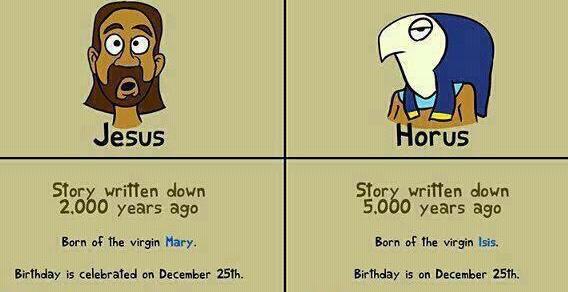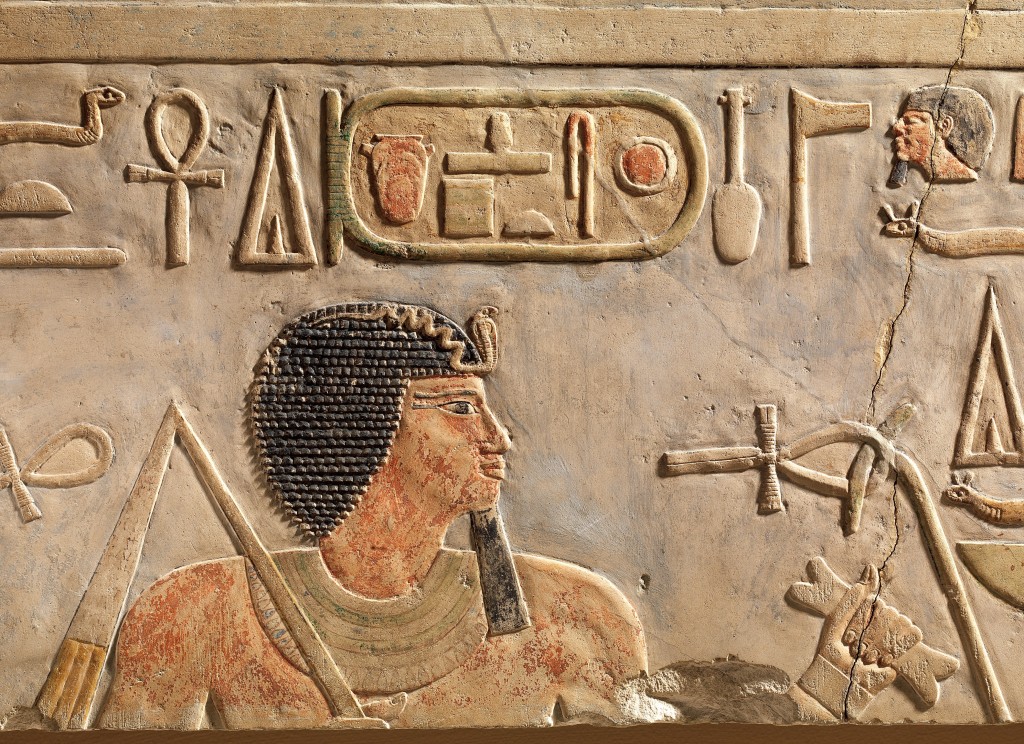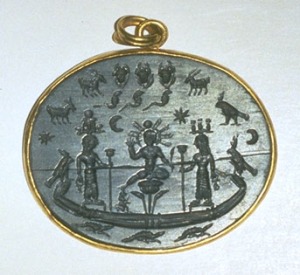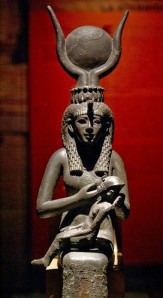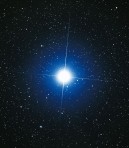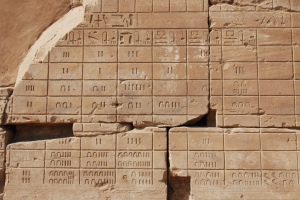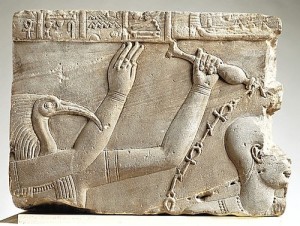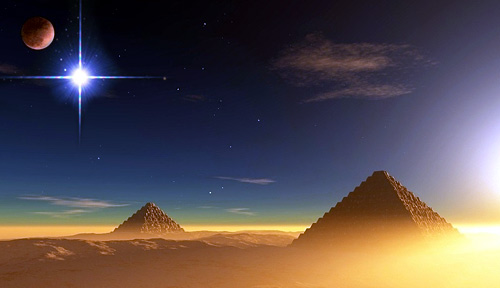Hello, Isiacs. I’m reposting this because, well, it’s that time of year and this question must be answered. Again.
Every year, at about this time, one post on this blog starts to get a lot more “traffic,” that is, visitors viewing it, than any other. (In fact, it’s already started.)
It’s the one about Horus being born on December 25th. Likely, people are searching for information about how Christianity absorbed Pagan winter solstice traditions (from the non-Christian side) or how it most certainly did not (from the Christian side). The statement about Horus’ birth on that date is often used to dismiss the Christian tradition of the birth of the Christ on December 25th (and by inference, Christian tradition in general) as “mere Pagan superstition.” Which is rude to both Pagans and Christians.
Early Christianity most certainly was influenced by the people and cultures around it. But the thing I specifically wanted to look into was the birth of Holy Baby Horus from the Holy Virgin Isis on December 25th.
What bothered me about it was that I thought that the December 25th date was stretching the truth to make a point; the point being that the “real meaning of Christmas” was, in fact, the celebration of a Pagan Deity Who was born on the winter solstice. Why should we have to distort the truth to make that point?
As you might expect from a sun-focused culture—the winter solstice was quite important in Egyptian culture and religion. There are many inscriptions and texts to support this, as well as a number of temples and monuments oriented toward the winter solstice sunrise. Temples with that orientation were often dedicated to Re-Hor-Akhty, Re-Horus of the Horizon.
In the 17th year of the reign of Pharaoh Amenemhet I (approx. 1991-1962 BCE), the king chose to take a new title as the sun approached winter solstice. The title was Nem-mestu, Repeater of Births. This designation was also given to the dead and may refer to daily/yearly solar rebirth or even to reincarnation.
But still, that’s the winter solstice, usually December 21 or 22, not December 25.
The Greek priest Plutarch, writing in the late 1st and early 2nd century CE, is our source for the most complete version of the Isis and Osiris myth that we have. In his essay, he mentions several Egyptian winter solstice traditions, including the birth of Harpokrates (from Hor-pa-khered, Horus the Child) on the winter solstice. (I quote it here at length because I like the snarky lead-in):
Thus we shall attack the many boring people who find pleasure in associating the activities of these gods with the seasonal changes of the atmosphere or with the growths, sowing, and plowing of crops, and who say that Osiris is being buried when the corn is sown and hidden in the earth, and that he lives again and reappears when it begins to sprout. For this reason it is said that Isis, when she was aware of her being pregnant, put on a protective amulet on the sixth day of Phaophi, and at the winter solstice gave birth to Harpocrates, imperfect and prematurely born, amid plants that burgeoned and sprouted before their season . . . and they are said to celebrate the days of her confinement after the spring equinox.
Plutarch, On Isis and Osiris, 65B-c
Since Horus is a solar God, His birth at the winter solstice—even to the extent that He is “imperfect and prematurely born” at that time—makes symbolic sense. (Calendar translation is always tricky, but in this later period, the 6th of Phaophi would be sometime in October or November by our calendar. So if Isis was going to give birth at the solstice, She would have had to have been pretty inattentive to have only worn a protective amulet that late in Her pregnancy. Seems more likely that She put on the protective amulet in the more dangerous weeks just prior to giving birth.) This tradition of Horus’ winter solstice birth was still going strong in the 4th and 5th centuries CE. Another writer, Macrobius, famous for his book about the Saturnalia festival, notes that:
…at the winter solstice, the sun would seem to be a little child like that which the Egyptians bring forth from a shrine on the appointed day, since the day is then at its shortest and the god is accordingly shown as a tiny infant.
Macrobius, Saturnalia, 1.18:10
The Egyptians weren’t the only ones to note and welcome the winter solstice with its soon-to-be-lengthening days. Just as there are today, there were other winter holy days around the time of the winter solstice. You’re probably familiar with the Roman Saturnalia (Greek Kronia) which took place from December 17th through the 23rd (at its most developed stage). It was a carnivalesque festival with plenty of partying and gift-giving on the last day, just a day or two from the astronomical solstice.
The 4th century CE Christian polemicist, Epiphanius, notes two very interesting Pagan festivals that took place “on the very night of Epiphany,” which is Epiphanius’ preferred date for the birth of the Christos (January 6). He grouches that “many places deceitfully celebrate a very great festival on the very night of the Epiphany, to deceive the idolaters who believe them into hoping in the imposture and not seeking the truth.” (Epiphanius, Panarion, 22,8) Of the celebration in Alexandria, he writes:
First, at Alexandria, in the Koreum, as they call it; it is a very large temple, the shrine of Kore. They stay up all night singing hymns to the idol with a flute accompaniment. And when they have concluded their nightlong vigil, torchbearers descend into an underground shrine after cockcrow and bring up a wooden image which is seated naked on a litter. It has a sign of the cross inlaid with gold on its forehead, two other such signs, one on each hand and two other signs, one actually on each of its two knees—altogether five signs with a gold impress. And they carry the image itself seven times around the innermost shrine with flutes, tambourines and hymns, hold a feast, and take it back down to its place underground. And when you ask them what this mystery means, they reply that today, at this hour Kore—that is, the Virgin—gave birth to Aion.
Epiphanius, Panarion, 22,9
Some scholars believe that the Alexandrian Kore or Virgin was Isis (some ancient Egyptian Hymns call Isis “virgin;” in the Hermetic text, Kore Kosmou, Isis is likely the “Cosmic Virgin” of the title) and that the “crosses” on Her limbs may have been ankhs. Could be, but doesn’t have to be; Alexandria was, after all, a polytheistic city. Epiphanius goes on to mention other identical and, in his mind, deceitful festivals in Petra and in Elusa celebrating the birth of the “only son of the Lord” of a Virgin Goddess. In Petra, the Holy Child is Dusares, an Arabian God identified with Dionysos, Who was, in turn, identified with Helios, the sun. (Epiphanius, Panarion, 22,11)
Those of you who have been following along with this blog may recall that the famous Roman Calendar of Philocalus (354 CE)* lists a festival called The Isia from October 28 through November 1.**
Much earlier, in the 1st century BCE, the Greek mathematician and astronomer Germinos noted that the Greeks believe that the Isia—which was derived from the ancient Egyptian Khoiak festival—occurs at the winter solstice. (The Khoiak festival celebrated the death of Osiris and His finding, lamentation, and resurrection by Isis.) Germinos says that that was true 120 years ago, but that, in his time, it had shifted a month earlier. The modern Kemetic Orthodox religion celebrates the Khoiak Festival in late November; so just about now.

However, here at the 45th parallel, we are happily privy to a calendar Mystery. The ancient Khoiak Festival took place in the fourth month of Inundation, which began on the Egyptian New Year. As you likely know, the New Year was heralded by the heliacal rising of Sirius, the Star of Isis. The festival took place over a period of many days, culminating at the end of the fourth month with the resurrection of Osiris.
Here in Portland, the Star of Isis rose this year on August 23. Four 30-day Egyptian months from that date is December 21, the winter solstice. So if you were here in Portland with me, we could celebrate the Isia on the days leading up to and ending with the winter solstice.
Yet, as fabulous as that is, it’s still not December 25th, is it?
Well, as it turns out, the answer to this little puzzle is not all that mysterious after all.
You see, the Roman calendar went through a certain amount of upheaval and—bottom line—December 25th was considered the “traditional” date of the winter solstice, even if that was off from astronomical solstice. (If you want to calendar geek on that, check this out or this.) From a number of ancient sources, including Epiphanius, we have that “the eighth before the kalends of January” was considered to be the winter solstice. (Epiphanius, Panarion, 22,3) Because of the inclusive way the Romans counted, this “eighth before the kalends” was December 25th. (In the Roman calendar, the kalends is the first day of the month.)
What’s more, the early Christians who chose that date, chose it precisely because it was the winter solstice and was connected to the return of the light. In a work attributed, perhaps falsely, to the 4th century Christian church father John Chrysostom, the writer connects the birth of Jesus with the birth of Sol Invictus, the Unconquerable Sun, which was celebrated on Rome’s traditional winter solstice, December 25th:
But Our Lord, too, is born in the month of December . . . the eighth before the kalends of January [25 December] . . ., But they call it the “Birthday of the Unconquered.” Who indeed is so unconquered as Our Lord? Or, if they say that it is the birthday of the sun, He is the Sun of Justice.
Chrysostom, De Solstitia et Aequinoctia Conceptionis et Nativitatis Nostri Iesu Christi et Iohannis Baptistae; “On the conceptions and births of our Jesus Christ and John the Baptist on the solstices and equinoxes.”
Another interesting thing about the choice of December 25th is that—even just those few days after the astronomical solstice—you can begin to see that the light is indeed returning. Some scholars have suggested that the December 25th date for the solstice reflects this perceivable change, so that even though the exact moment of astronomical solstice is prior to the 25th, it becomes noticeable about the 25th.
So there we have it. There actually IS reason to connect the winter solstice birth date of Isis’ Holy Child, Horus, with the traditional December 25th birth date of Mary’s Holy Child, Jesus.
Should we claim that early Christians “stole” the birthdate of Horus (or any of the other solar Gods Who always were and always will be born on the winter solstice)? Nah, let’s not. In fact, it makes perfect sense to celebrate the birth of Jesus Christ, the bringer of the light of Christianity to its believers, at that time of year when the light of the sun begins its return to the world. It is an excellent symbol and early Christians would have been silly to ignore it.
Of course early Christianity was influenced by the many religions around it. And remember that much early Christian development was in Alexandria, Egypt. For early Christians, as for ancient Egyptians—and indeed for modern people as well—the return of the light at the winter solstice is at once an uplifting environmental fact and a hopeful spiritual symbol.
And so, as we begin the count down in the waning days of the year, I wish you all Many Happy Returns of the Light as we celebrate the upcoming holy days of December 21st and December 25th.
*The reason Philocalus’ calendar is so famous, is that it contains the oldest reference to a regular celebration of the birth of the Christos. The calendar notes: “Eighth day before the kalends of January, Birth of Christ in Bethlehem of Judea.” Earlier, one of the Church fathers, Cyprian (200-258CE), commented how very, very providential it was the when the sun was born, so was Christ.
**If we go by Philocalus, that late October-early November date for the Isia, with its emphasis on death, lamentation, and renewal, makes a perfect option for our own Samhaim/Halloween celebrations.



